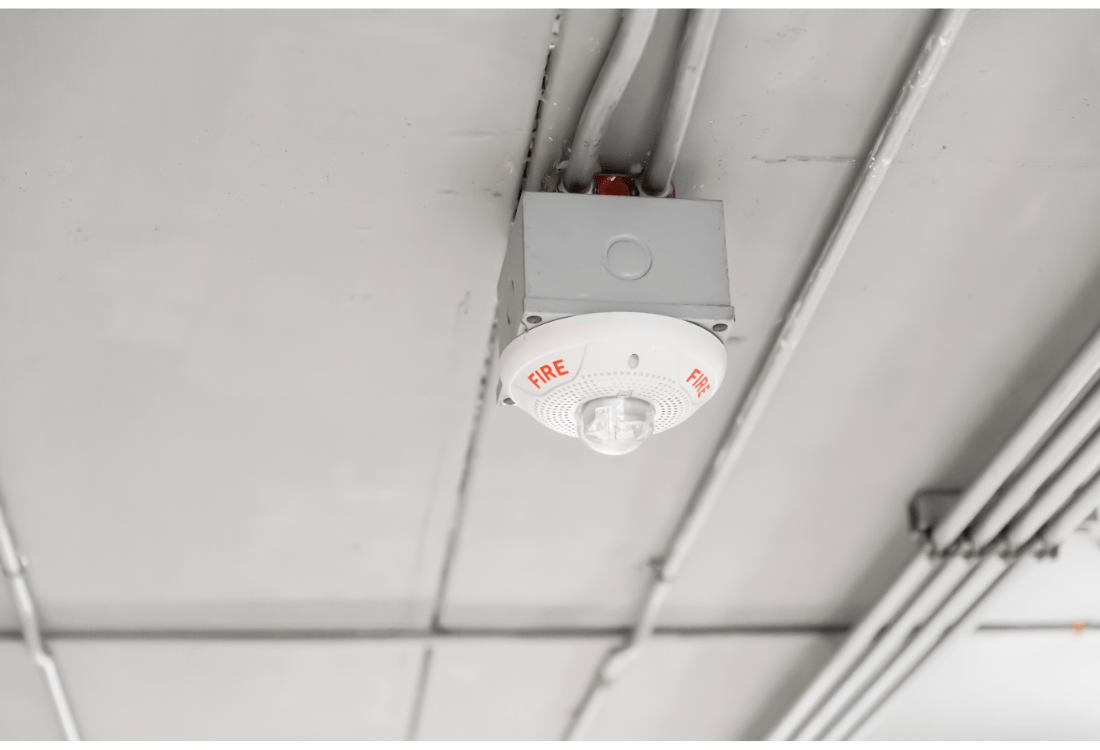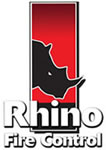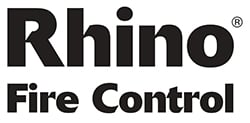
What Type Of Fire Alarm Do I Need For My Commercial Building?
Fire alarms are all designed to give the occupants of a building early warning of a fire so that they can evacuate safely, but there are several types of commercial fire alarms available that each detect heat or smoke particles in slightly different ways. To decide which variety of fire alarms to deploy in your business premises, it pays to know the basics of these sensors’ functionality and the kinds of fires they are designed to detect.
Ionisation Detectors
Detects small particles of smoke from flaming fires and provides early warning before the smoke becomes too thick.
Ionisation smoke detectors have various applications in industrial and commercial buildings, and their placement requires careful consideration. Effective locations include:
-
Ceilings of large rooms: this enables the device to detect small smoke particles as they rise and congregate around the ceiling. In large open plan rooms, such as call centres or factories, multiple detectors may be required.
-
Stairwells and hallways: smoke can travel quickly through these access areas, and it is therefore essential to have detectors in place at strategic points to provide early warning.
-
Away from air vents: ionisation detectors are sensitive to draughts that might interfere with their operation, so install your alarms well clear of air vents, doors, or windows.
-
Special hazard areas: locations such as commercial kitchens, garages, and workshops where there may be a higher risk of fire should have at least one ionisation detector installed.
How they work: Ionisation smoke alarms work with an ionisation chamber, which consists of two charged metal plates with ionised air molecules between them. These molecules allow a current to pass unimpeded between the two plates. However, when smoke particles enter, the voltage level falls and when this drops below a certain threshold, an alarm is triggered. Ionisation detectors are cheap and effective, and able to detect fires early before the smoke gets too thick.
Optical Beam Smoke Detection
Detects larger particles of smoke when a slow-burning or smouldering fire is already established.
Optical beam smoke detectors are a good choice for detecting the large particles produced by smouldering and slow burning fires, such as fires in offices and storage rooms that contain lots of paper, and are also useful in large spaces where other smoke detectors may be as effective. Good installation areas include:
-
High ceilinged rooms: optical beam detectors are ideal for rooms with high ceilings, such as warehouses, because they can detect smoke over larger areas and greater heights.
-
Large open spaces: Optical beam detectors provide excellent fire detection in large open plan offices and atriums in which partitioning and ceiling-mounted detectors are impractical.
-
Difficult to access areas: these detectors can be used effectively in areas that are difficult to access or maintain, such as vaulted ceilings.
To work effectively, an optical beam detector must have a clear line of sight with no obstructions, with an appropriate distance between the detector and reflector (if the detector is a reflected type). The specific distance varies by model, so please check the manufacturer’s instructions before installing your detector. You should also avoid installing optical beam detectors near strong light sources, which could interfere with the detector’s operation.
How they work: Optical or photoelectric detectors work by employing a low-power laser or white light beam alongside a detecting lens. One approach is to trigger an alarm once smoke is thick enough to block the beam. However, this approach is usually not adequately sensitive. Therefore, most devices instead function by detecting light that is refracted at right angles to the main beam by the presence of smoke particles.
Heat Alarms
Insensitive to smoke but can detect an increase in temperature that could indicate an early-stage fire.
Heat alarms or heat detectors are typically deployed in environments where dust, fumes, steam, or smoke are normally present and might therefore cause false alarms with smoke detectors. These alarms provide a good level of fire protection in the following applications:
-
Commercial kitchens and food preparation areas: heat alarms are often placed in commercial kitchens and food processing areas in which cooking takes place, because they are less likely to give false alarms caused by cooking smoke or steam.
-
Boiler rooms and commercial laundries: these areas frequently operate at high temperatures that can trigger false alarms in some smoke detectors. Heat detectors are better suited for these environments due to their greater precision and accuracy.
-
Garages and workshops: the dust and exhaust fumes that are always present in workshops and garages can trigger false alarms with smoke detectors.
-
High dust areas: industrial areas with high levels of dust, such as woodworking shops and cement factories, are also prone to false smoke alarms, so heat alarms should be installed near the ceiling to detect anomalous temperature rises.
To work effectively, heat alarms should be placed away from windows, fans, or vents where drafts could delay the detection of heat, and most detectors are not suitable for installation in unheated areas or spaces where the temperature can drop below freezing point, as this can affect the device’s operation and accuracy.
How they work: Heat detectors respond to changes in temperature rather than smoke levels and can be triggered by temperatures passing a fixed threshold, or by reacting to a sudden increase in the rate of change of temperature. Each alarm only covers a small area, so several may be needed to cover larger spaces.
Combined Optical Smoke And Heat Alarms
Excellent combined safety devices for detecting slow, smouldering fires and rapid temperature increases.
Combine smoke and heat alarms offer the best of both worlds in fire detection, being capable of both optical detection for smoke and heat detection. General guidelines for installation include:
-
Central locations: install these combined alarms in central locations within your premises to maximise coverage.
-
Rooms with electrical equipment: devices mounted in rooms containing a lot of electrical equipment, such as control rooms, meeting and conference rooms, server rooms, and offices, can quickly detect the presence of an electrical fire, which produces both smoke and heat.
-
Primary evacuation routes: hallways and corridors used as a primary means of escape during a fire should be equipped with combined early detection devices to minimise hazards during evacuation.
Combined heat and smoke alarms should be installed away from air vents and windows to avoid drafts interfering with their operation, e.g. by reducing heat or dispersing smoke.
How they work: For environments where different types of fires are possible, combination alarms may be installed to increase detection speed. They are often placed on landings or corridors where fires could emerge from different sources. Combined optical smoke and heat alarms reduce false positives as thresholds can be set high enough to avoid accidental triggering while still allowing early detection of different types of fires.
Combined Smoke And Carbon Monoxide Alarms
Combined smoke detection with a carbon monoxide alarm for improved safety in sensitive areas.
Combine smoke and carbon monoxide arms are valuable fire safety assets in several commercial and industrial environments, providing early warning of raised CO levels, as well as potential fires. Placement guidelines include:
-
Rooms with fuel-burning appliances: rooms containing plant or appliances that burn fuel or emit exhaust fumes, such as industrial kilns, furnaces, ovens, heaters, and gas boilers, should have a combined CO/smoke detector installed nearby, as these appliances can all produce excess carbon monoxide.
-
High on walls: carbon monoxide mixes with air and doesn’t rise like smoke, so a CO alarm can be installed at any height. However, because heated smoke rises, a combined smoke and CO alarm should be installed relatively high on walls (but not touching the ceiling).
-
Near sleeping areas: if your building has sleeping quarters for shift workers, combined smoke and carbon monoxide alarms should be installed inside and outside each bedroom or dorm area to provide adequate warning to sleepers.
How they work: smoke and carbon monoxide (CO) detectors save money and space by protecting against multiple risks without needing to install different types of detectors in the same location. The CO detection aspect is particularly valuable, as it can alert people to toxic but otherwise unnoticeable gases which may accompany or precede a fire.
Aspirating Smoke Detectors
Extremely sensitive smoke detectors that can often detect a fire before there is visible smoke, let alone flames.
Aspirating Smoke detection, or air sampling detection devices, are designed to detect fires in their very early stages by actively drawing air from the protected area through a network of pipes into a detection unit.
-
Early detection: Aspirating smoke alarms are perfect for use in environments in which early detection is critical, such as data centres, archives, laboratories, clean rooms, and busy offices.
-
Temperature -controlled environments: Aspirating smoke alarms are also useful in applications where traditional smoke detectors may not work as well, such as cold storage facilities and commercial freezers, in which smoke stratification can prevent smoke from reaching ceiling mounted detectors, and in high airflow areas, such as server rooms, where smoke may become too diluted for traditional detectors to pick up quickly.
How they work: the detector device continually draws in air from the environment through a network of small pipes, after which the air is analysed for the presence of smoke particles. This is usually done using a laser-based system or cloud chamber that can identify the tiny particles of combustion. If smoke particles are detected in sufficient quantities, the system triggers an alarm.
Linear Heat Detection
Detects fires in environments where other forms of detection are not suitable, including harsh or hazardous conditions and large open spaces.
Linear heat detection uses heat sensitive cables to detect changes in temperature along their length. These cables can be installed in a variety of open-plan industrial environments and are perfect for protecting large areas or assets. General guidelines for installation include:
-
Overheating equipment: linear heat detectors can be looped around plant and machinery that could potentially overheat.
-
Perimeters: detector cables can be circled around the inside perimeter of tunnels, open spaces, or specific structures or areas.
-
Sidewalls: linear heat detectors provide wide area detection when installed on sidewalls close to the ceiling of a large open building.
-
Cabling: linear heat detection cables can be installed adjacent to electrical cables or cable tray applications to detect fires caused by overheating and electrical faults.
How they work: linear heat detectors are thermally sensitive cables that respond to heat, and are installed along the lengths of walls, ceilings, and other structures (e.g. industrial construction plant) that need to be protected. The cables are designed to detect a specific temperature threshold or a rapid rate of rise in temperature. When the cable reaches its predetermined trigger threshold, the cable insulation melts, which triggers an alarm. Once the alarm is triggered, it alerts the building’s fire control panel, which then initiates the appropriate response, such as an audible alarm or activating a fire suppression system.
Next Steps
To learn more about the different types of fire alarms and which is best for your organisation, please contact Rhino Fire Control today for an expert consultation.
Image Source: Canva




